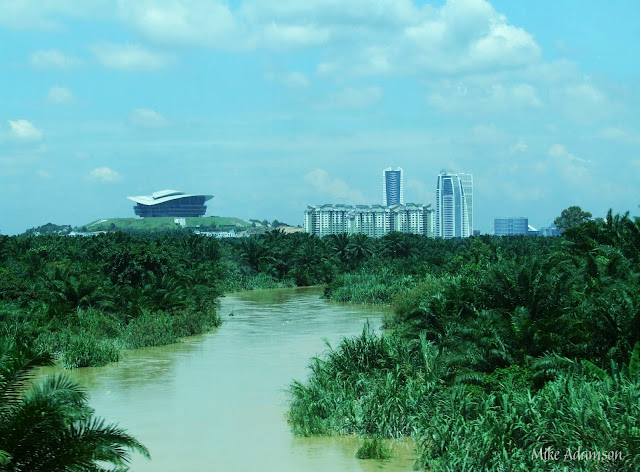
Kinchina is a CP, or Conservation Park, not far from Murray Bridge -- in fact, it's adjacent to the Mobilong facility. Dave and I went there to spot birds (no joy: barely even heard any, and saw just one ... no photos worth sharing). But instead, we saw something we have NEVER seen before. And although I was thrilled and privileged to see this incredible animal, I actually hope not to see another like him. I'll call him Thunderfoot, because --
When he took a STEP -- not hopping, just stepping forward -- the impact of those immense feet sounded like a horse cantering over soft ground. Thudd!!!!
And then Dave spotted the male. The one who made that heavy, dense, soft thuddd every time he took a step. When you weigh about 200 kilos, this is what it's going to sound like -- and this weight estimation is based on observation and cold, hard logic. A horse easily weighs more, but it sounds comparatively loud because all that weight is falling on a small area, the hoof: a horse walks on its middle toe, right? Now, consider an animal which is not called a macropod, or big-foot, for no reason. His feet are immense. To hear that same "shire horse cantering" type of thuddd sound, you'll need an utterly enormous weight spread out over that huge foot.
The size of him ...
Those are trees, not shrubs, around him. That's a boulder, not a little rock, just left of centre of this frame. Now, look at the foliage on the foreground tree: mark the scale of it ... but this animal is standing at least eight meters, probably closer to ten, behind that foliage!!
At left here, Dave is standing beside one of the mock-up ancestral animals at the Womambi Fossil Centre, back in 2009. It's one of the extinct tree-browsing kangaroos. (Imagine the proverbial Really Big Roo with the face of a koala, which evolution designed to reach up and browse tree foliage.) The critter at Kinchina, whom we're calling Thunderfoot, is waaaay bigger than this extinct browser.Think of the biggest male roo you've ever seen at Belair NP, or Onkaparinga Gorge, or wherever, and -- literally double it.
It was like looking at a shire horse, and when he moved, that's what it sounded like, back among the trees.
I've never before felt that frisson of "Oh, oh ..." when coming across a roo in the wild. Never saw one that concerned me, much less made the breath shorten and the hair rise on the back of the neck.
Very carefully, I doubled back around to get a line-of-sight on him without trees in the foreground...
There's nothing for perspective in that shot, but we can tell you this much: if he were to stand up straight, his head would be around nine feet off the ground. Up on those toes? Standing in your living room, his head would be right through the ceiling. His shoulders ... it was like looking at a bull --
A bull that has seen you, is looking right at you, and you're in his territory, and his female is only twenty meters away. For all we knew, there could have been a joey (his baby) in the area, which makes any wild animal protective. He was intent on me, likely for good reason. No way in any world would this animal be leery of a puny little human, but where his joey is concerned...
I popped a couple of quick frames, then very carefully turned around. To be safe, you walk at right-angles to a big, wild roo: you don't make eye contact, and you do not move like you're slinking or sneaking. Slinky walking, eye contact and walking directly toward them emulates the stalking characteristics of the only predator evolution ever threw at animals this big. There haven't been wild dingoes in this part of South Australia for many years -- I don't even know if they're even still wild up in the state's north. But the programming of evolution isn't going to change, not in another million years.
So we walked on, and heard Thunderfoot and his enormous missus boom off into the bushland. It was thrilling, a little bit scary -- like almost but not quite blundering into a grizzly bear in bush Alaska. I wouldn't trade the experience for anything, yet at the same time, I hope not to repeat it! I honestly did not know that roos grew this big -- and yes, I know exactly what the official documentation says! But I also know what Dave and I experienced. We're savvy people, and entirely used to Clydesdale horses, wild bull moose in Kincaid Park, camels ... those taxidermed bears in the big glass cases at Anchorage Airport! We know what we saw.
And I won't be diving through the bush with quite the abandon that I used to! Radar on, wits about you, and make enough noise that wildlife can hear you coming! Because it's bigger that you are. A lot bigger. And it has eight-inch talons! It's very fortunate indeed that roos, even humongous ones, are such peaceable herbivores: they absolutely will not attack you ... unless you give them a justifiable reason, like startling them by running right into them, which would make any animal come up swinging.
So -- don't given them a reason!





















































